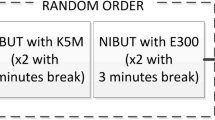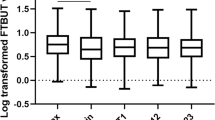Abstract
Purpose
To assess the repeatability and reliability of different commercially available diagnostic platforms in the objective assessment of tear film parameters and if there exists any agreement between them.
Methods
Thirty healthy individuals (N = 60 eyes) and fifteen DED patients (N = 30 eyes) had their tear film parameters (Lipid layer thickness (LLT), Tear meniscus height (TMH), Non-invasive tear break up time (NIBUT)) assessed using three instruments - LipiView® II, IDRA ocular surface analyser (IDRA-OSA) and Oculus keratograph 5 M (K5M). Bland-Altman analysis and linear mixed effects modelling & Generalized Linear Hypothesis Test were used for analysis and coefficient of variation (CoV).
Results
There is poor repeatability but good reproducibility of LLT values measured with Lipiview, or IDRA. NIBUT using K5M & IDRA-OSA shows good repeatability and reproducibility in control group but poor repeatability in DED patients. TMH values obtained with K5M or IDRA-OSA had poor repeatability with high CoV. Between two observers, good reproducibility is observed for TMH and NIBUT values using both K5M & IDRA-OSA but not for LLT values. Between instruments, all the measurements (LLT, NIBUT and TMH) were significantly different on Bland Altman analysis.
Conclusion
No two dry eye diagnostic platforms can be used interchangeably and non-invasive tear film values should be interpreted keeping in mind the individual machine’s variability. The high coefficient of variation in DED patients compared to normal reflects inherent variability in tear film irrespective of the device used.
This is a preview of subscription content, access via your institution
Access options
Subscribe to this journal
Receive 18 print issues and online access
$259.00 per year
only $14.39 per issue
Buy this article
- Purchase on Springer Link
- Instant access to full article PDF
Prices may be subject to local taxes which are calculated during checkout


Similar content being viewed by others
Data availability
Supplementary file contains the statistical data. Raw data are available with authors and can be shared upon reasonable request.
References
Wolffsohn JS, Arita R, Chalmers R, Djalilian A, Dogru M, Dumbleton K, et al. TFOS DEWS II diagnostic methodology report. Ocul Surf. 2017;15:539–74.
Eom Y, Lee JS, Kang SY, Kim HM, Song JS. Correlation between quantitative measurements of tear film lipid layer thickness and meibomian gland loss in patients with obstructive meibomian gland dysfunction and normal controls. Am J Ophthalmol. 2013;155:1104–10.e1102.
Fernández J, Rodríguez-Vallejo M, Martínez J, Tauste A, García-Montesinos J, Piñero DP. Agreement and repeatability of objective systems for assessment of the tear film. Graefes Arch Clin Exp Ophthalmol. 2018;256:1535–41.
García-Marqués JV, Martínez-Albert N, Talens-Estarelles C, García-Lázaro S, Cerviño A. Repeatability of non-invasive keratograph break-up time measurements obtained using Oculus Keratograph 5M. Int Ophthalmol. 2021;41:2473–83.
Best N, Drury L, Wolffsohn JS. Clinical evaluation of the Oculus Keratograph. Cont Lens Anterior Eye. 2012;35:171–4.
Tian L, Qu JH, Zhang XY, Sun XG. Repeatability and reproducibility of noninvasive keratograph 5M measurements in patients with dry eye disease. J Ophthalmol. 2016;8013621.
Zhao Y, Tan CL, Tong L. Intra-observer and inter-observer repeatability of ocular surface interferometer in measuring lipid layer thickness. BMC Ophthalmol. 2015;15:53.
Markoulli M, Duong TB, Lin M, Papas E. Imaging the tear film: a comparison between the Subjective Keeler Tearscope-Plus™ and the Objective Oculus® Keratograph 5M and LipiView® Interferometer. Curr Eye Res. 2018;43:155–62.
Arriola-Villalobos P, Fernández-Vigo JI, Díaz-Valle D, Peraza-Nieves JE, Fernández-Pérez C, Benítez-Del-Castillo JM. Assessment of lower tear meniscus measurements obtained with Keratograph and agreement with Fourier-domain optical-coherence tomography. Br J Ophthalmol. 2015;99:1120–5.
Wolffsohn JS, Arita R, Chalmers R, Djalilian A, Dogru M, Dumbleton K, et al. TFOS DEWS II diagnostic methodology report. Ocul Surf. 2017;15:539–74.
Nichols KK, Mitchell GL, Zadnik K. The repeatability of clinical measurements of dry eye. Cornea. 2004;23:272–85.
Jung JW, Park SY, Kim JS, Kim EK, Seo KY, Kim TI. Analysis of factors associated with the tear film lipid layer thickness in normal eyes and patients with dry eye syndrome. Investig Ophthalmol Vis Sci. 2016;57:4076–83.
Lee JM, Jeon YJ, Kim KY, Hwang KY, Kwon YA, Koh K. Ocular surface analysis: a comparison between the LipiView® II and IDRA®. Eur J Ophthalmol. 2021;31:2300–6.
Wei A, Le Q, Hong J, Wang W, Wang F, Xu J. Assessment of lower tear meniscus. Optom Vis Sci. 2016;93:1420–5.
Vigo L, Pellegrini M, Bernabei F, Carones F, Scorcia V, Giannaccare G. Diagnostic performance of a novel noninvasive workup in the setting of dry eye disease. J Ophthalmol. 2020:5804123. https://doi.org/10.1155/2020/5804123.
Cox SM, Nichols KK, Nichols JJ. Agreement between automated and traditional measures of tear film breakup. Optom Vis Sci. 2015;92:257–e263.
Singh S, Srivastav S, Mohamed A, Basu S. Non-invasive tear film assessment in normal population: effect of age, sex, and interparametric relationship. Front Med. 2022;9:894184.
Funding
Hyderabad Eye Research Foundation (HERF), India.
Author information
Authors and Affiliations
Contributions
SS and SB were responsible for designing the study protocol, writing the protocol and IRB, conducting the literature review and writing the manuscript along with interpreting results, and creating tables. SSA and ZM were responsible for performing the tear film imaging and extracting the data from machines and electronic records. SSA contributed to figure designing as well. MHA conducted the statistical analyses and contributed to analysing data and interpreting results.
Corresponding authors
Ethics declarations
Competing interests
The authors declare no competing interests.
Additional information
Publisher’s note Springer Nature remains neutral with regard to jurisdictional claims in published maps and institutional affiliations.
Supplementary information
Rights and permissions
Springer Nature or its licensor (e.g. a society or other partner) holds exclusive rights to this article under a publishing agreement with the author(s) or other rightsholder(s); author self-archiving of the accepted manuscript version of this article is solely governed by the terms of such publishing agreement and applicable law.
About this article
Cite this article
Singh, S., Srivastav, S., Modiwala, Z. et al. Repeatability, reproducibility and agreement between three different diagnostic imaging platforms for tear film evaluation of normal and dry eye disease. Eye 37, 2042–2047 (2023). https://doi.org/10.1038/s41433-022-02281-2
Received:
Revised:
Accepted:
Published:
Issue Date:
DOI: https://doi.org/10.1038/s41433-022-02281-2



